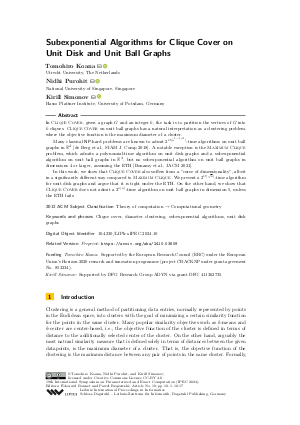Subexponential Algorithms for Clique Cover on Unit Disk and Unit Ball Graphs
Authors
Tomohiro Koana  ,
Nidhi Purohit
,
Nidhi Purohit  ,
Kirill Simonov
,
Kirill Simonov 
-
Part of:
Volume:
19th International Symposium on Parameterized and Exact Computation (IPEC 2024)
Part of: Series: Leibniz International Proceedings in Informatics (LIPIcs)
Part of: Conference: International Symposium on Parameterized and Exact Computation (IPEC) - License:
 Creative Commons Attribution 4.0 International license
Creative Commons Attribution 4.0 International license
- Publication Date: 2024-12-05
File

PDF
LIPIcs.IPEC.2024.10.pdf
- Filesize: 0.91 MB
- 17 pages
Document Identifiers
Related Versions
- Preprint https://arxiv.org/abs/2410.03609
Subject Classification
ACM Subject Classification
- Theory of computation → Computational geometry
Keywords
- Clique cover
- diameter clustering
- subexponential algorithms
- unit disk graphs
Metrics
- Access Statistics
-
Total Accesses (updated on a weekly basis)
0PDF Downloads0Metadata Views
Abstract
In Clique Cover, given a graph G and an integer k, the task is to partition the vertices of G into k cliques. Clique Cover on unit ball graphs has a natural interpretation as a clustering problem, where the objective function is the maximum diameter of a cluster.
Many classical NP-hard problems are known to admit 2^{O(n^{1 - 1/d})}-time algorithms on unit ball graphs in ℝ^d [de Berg et al., SIAM J. Comp 2018]. A notable exception is the Maximum Clique problem, which admits a polynomial-time algorithm on unit disk graphs and a subexponential algorithm on unit ball graphs in ℝ³, but no subexponential algorithm on unit ball graphs in dimensions 4 or larger, assuming the ETH [Bonamy et al., JACM 2021].
In this work, we show that Clique Cover also suffers from a "curse of dimensionality", albeit in a significantly different way compared to Maximum Clique. We present a 2^{O(√n)}-time algorithm for unit disk graphs and argue that it is tight under the ETH. On the other hand, we show that Clique Cover does not admit a 2^{o(n)}-time algorithm on unit ball graphs in dimension 5, unless the ETH fails.
Cite As Get BibTex
Tomohiro Koana, Nidhi Purohit, and Kirill Simonov. Subexponential Algorithms for Clique Cover on Unit Disk and Unit Ball Graphs. In 19th International Symposium on Parameterized and Exact Computation (IPEC 2024). Leibniz International Proceedings in Informatics (LIPIcs), Volume 321, pp. 10:1-10:17, Schloss Dagstuhl – Leibniz-Zentrum für Informatik (2024)
https://doi.org/10.4230/LIPIcs.IPEC.2024.10
BibTex
@InProceedings{koana_et_al:LIPIcs.IPEC.2024.10,
author = {Koana, Tomohiro and Purohit, Nidhi and Simonov, Kirill},
title = {{Subexponential Algorithms for Clique Cover on Unit Disk and Unit Ball Graphs}},
booktitle = {19th International Symposium on Parameterized and Exact Computation (IPEC 2024)},
pages = {10:1--10:17},
series = {Leibniz International Proceedings in Informatics (LIPIcs)},
ISBN = {978-3-95977-353-9},
ISSN = {1868-8969},
year = {2024},
volume = {321},
editor = {Bonnet, \'{E}douard and Rz\k{a}\.{z}ewski, Pawe{\l}},
publisher = {Schloss Dagstuhl -- Leibniz-Zentrum f{\"u}r Informatik},
address = {Dagstuhl, Germany},
URL = {https://drops.dagstuhl.de/entities/document/10.4230/LIPIcs.IPEC.2024.10},
URN = {urn:nbn:de:0030-drops-222369},
doi = {10.4230/LIPIcs.IPEC.2024.10},
annote = {Keywords: Clique cover, diameter clustering, subexponential algorithms, unit disk graphs}
}
Author Details
Funding
- Koana, Tomohiro: Supported by the European Research Council (ERC) under the European Union’s Horizon 2020 research and innovation programme (project CRACKNP under grant agreement No. 853234).
- Simonov, Kirill: Supported by DFG Research Group ADYN via grant DFG 411362735.
References
- Hans L. Bodlaender. A linear-time algorithm for finding tree-decompositions of small treewidth. SIAM J. Comput., 25(6):1305-1317, 1996. URL: https://doi.org/10.1137/S0097539793251219.
- Marthe Bonamy, Édouard Bonnet, Nicolas Bousquet, Pierre Charbit, Panos Giannopoulos, Eun Jung Kim, Pawel Rzazewski, Florian Sikora, and Stéphan Thomassé. EPTAS and subexponential algorithm for maximum clique on disk and unit ball graphs. J. ACM, 68(2):9:1-9:38, 2021. URL: https://doi.org/10.1145/3433160.
- Heinz Breu and David G. Kirkpatrick. Unit disk graph recognition is np-hard. Computational Geometry, 9(1):3-24, 1998. Special Issue on Geometric Representations of Graphs. URL: https://doi.org/10.1016/S0925-7721(97)00014-X.
- Vasilis Capoyleas, Günter Rote, and Gerhard J. Woeginger. Geometric clusterings. J. Algorithms, 12(2):341-356, 1991. URL: https://doi.org/10.1016/0196-6774(91)90007-L.
- Brent N. Clark, Charles J. Colbourn, and David S. Johnson. Unit disk graphs. Discret. Math., 86(1-3):165-177, 1990. URL: https://doi.org/10.1016/0012-365X(90)90358-O.
- Mark de Berg, Hans L. Bodlaender, Sándor Kisfaludi-Bak, Dániel Marx, and Tom C. van der Zanden. A framework for exponential-time-hypothesis-tight algorithms and lower bounds in geometric intersection graphs. SIAM J. Comput., 49(6):1291-1331, 2020. URL: https://doi.org/10.1137/20M1320870.
- Adrian Dumitrescu and János Pach. Minimum clique partition in unit disk graphs. Graphs Comb., 27(3):399-411, 2011. URL: https://doi.org/10.1007/s00373-011-1026-1.
- Venkatesan Guruswami and Sanjeev Khanna. On the hardness of 4-coloring a 3-colorable graph. SIAM J. Discret. Math., 18(1):30-40, 2004. URL: https://doi.org/10.1137/S0895480100376794.
- Russell Impagliazzo and Ramamohan Paturi. On the complexity of k-SAT. J. Comput. Syst. Sci., 62(2):367-375, 2001. URL: https://doi.org/10.1006/jcss.2000.1727.
- Russell Impagliazzo, Ramamohan Paturi, and Francis Zane. Which problems have strongly exponential complexity? J. Comput. Syst. Sci., 63(4):512-530, 2001. URL: https://doi.org/10.1006/jcss.2001.1774.
- Ross J. Kang and Tobias Müller. Sphere and dot product representations of graphs. Discret. Comput. Geom., 47(3):548-568, 2012. URL: https://doi.org/10.1007/S00454-012-9394-8.
- Sanjeev Khanna, Nathan Linial, and Shmuel Safra. On the hardness of approximating the chromatic number. Comb., 20(3):393-415, 2000. URL: https://doi.org/10.1007/S004930070013.
- Imran A. Pirwani and Mohammad R. Salavatipour. A weakly robust PTAS for minimum clique partition in unit disk graphs. Algorithmica, 62(3-4):1050-1072, 2012. URL: https://doi.org/10.1007/S00453-011-9503-8.
